Podcast: Play in new window | Download
Subscribe: Apple Podcasts | RSS
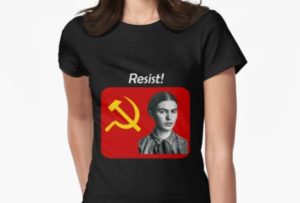
Get the official t-shirt for the show here: https://teespring.com/frida-kahlo-resist?tsmac=store&tsmic=mexico-unexplained&pid=266&cid=6174
The date was Thursday, May 12th 2016 and it was a beautiful spring day in New York City. As the temperatures cooled and the city settled into a quiet weekday evening, excitement abounded at Christie’s auction house. The big event was Christie’s Impressionist & Modern Art Evening Sale. Featured at the sale were some big names in the art world: Picasso, Monet, Matisse, and several other 20th Century giants. Of particular interest in this sale was a small painting made by Mexican artist Frida Kahlo in 1939 titled “Dos desnudos en el bosque” which translates to English, “Two Nudes in the Forest,” featuring a small monkey looking out from a jungle on two women in a tender embrace. By the end of the evening the painting had made history: It sold for a little over $8 million and became the highest-selling Mexican painting ever to sell at auction and one of the highest-selling paintings by a female artist of all time. I remembered hearing the news and couldn’t help but think what Frida herself would have thought of such an unbridled display of capitalism in motion. As an avowed Marxist-Leninist and a card-carrying member of the Mexican Communist Party for decades, how would such a sale have meshed with Frida’s political sensibilities? It turns out that the story of Frida Kahlo’s political activism is a long and convoluted tale.
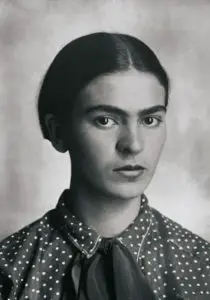 Frida Kahlo was born in the Mexico City suburb of Coyoacán on July 7, 1907 in the waning days of the Porfiriato, the decades-long dictatorship of Porfirio Díaz, and during her childhood she experienced the Mexican Revolution unfolding around her which interested her and played an important role in shaping her. In fact, later in her life she would publicly claim her birth year as 1910 so as to coincide with the beginning of the Mexican Revolution, one of the many instances of Frida’s use of “artistic license” to redefine her life and make it fit her own agendas and whimsies. In Frida’s early teen years the country of Mexico had come out of the Revolution with new ideas and struggled to redefine itself. New social movements emerged and Mexico looked inward to discover what it really looked like. A growing awareness of Mexico’s indigenous past, previously only relegated to the stuff of myths, emerged and fought for space alongside Mexico’s desire to be more European and modern. The old order of the Porfiriato would be replaced with something else and in the days immediately after the Revolution Mexico was not quite sure what that would be. It was an exciting time to be young, and Frida was in the thick of things as a student at the National Preparatory School in Mexico City, one of the first females to be admitted to what was seen as the finest high school in Mexico. In her later activism as a communist, Frida would give little credit to the upper-middle class privilege that gave her the opportunity to study at that school and be exposed to all of the new social ideas percolating at the time. While at the school Frida learned how to speak two foreign languages – English and French – and had profound and heated discussions with her peers – who hailed from some of the most elite families in the country – about such things as social justice, science and history. Here Kahlo received quite a political education both inside and outside the classroom and considered herself a “daughter of the Revolution.” Her friends from that time period in her life would become successful members of the Mexican social and political upper class.
Frida Kahlo was born in the Mexico City suburb of Coyoacán on July 7, 1907 in the waning days of the Porfiriato, the decades-long dictatorship of Porfirio Díaz, and during her childhood she experienced the Mexican Revolution unfolding around her which interested her and played an important role in shaping her. In fact, later in her life she would publicly claim her birth year as 1910 so as to coincide with the beginning of the Mexican Revolution, one of the many instances of Frida’s use of “artistic license” to redefine her life and make it fit her own agendas and whimsies. In Frida’s early teen years the country of Mexico had come out of the Revolution with new ideas and struggled to redefine itself. New social movements emerged and Mexico looked inward to discover what it really looked like. A growing awareness of Mexico’s indigenous past, previously only relegated to the stuff of myths, emerged and fought for space alongside Mexico’s desire to be more European and modern. The old order of the Porfiriato would be replaced with something else and in the days immediately after the Revolution Mexico was not quite sure what that would be. It was an exciting time to be young, and Frida was in the thick of things as a student at the National Preparatory School in Mexico City, one of the first females to be admitted to what was seen as the finest high school in Mexico. In her later activism as a communist, Frida would give little credit to the upper-middle class privilege that gave her the opportunity to study at that school and be exposed to all of the new social ideas percolating at the time. While at the school Frida learned how to speak two foreign languages – English and French – and had profound and heated discussions with her peers – who hailed from some of the most elite families in the country – about such things as social justice, science and history. Here Kahlo received quite a political education both inside and outside the classroom and considered herself a “daughter of the Revolution.” Her friends from that time period in her life would become successful members of the Mexican social and political upper class.
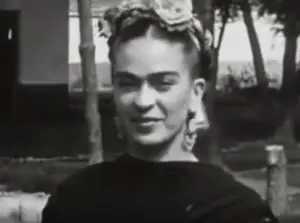 In her post-high-school years Frida reveled in the modernity of 1920s Mexico City. While most of the country of Mexico was still extremely poor, Frida had no connection or interest in what was happening in the countryside. The Mexico City of the 1920s was a permissive place full of free expression, much like Paris or Berlin of the same era. It was then when Frida became engrossed in the café scene and joined groups of other young people to explore such topics as feminism, communism and polyamory. It was then and there where Frida met the Marxists, communists and political exiles that would influence her. At a party held by the Italian-American photographer Tina Modotti in June of 1928, when Frida was almost 21 years old, Kahlo met her future husband, Diego Rivera, the avowed communist Mexican muralist who had returned to Mexico from France some 7 years before. Kahlo had met Rivera briefly a few years earlier, but it was at the party in 1928 when they initiated their love affair that would eventually lead to their tumultuous union. Some of Diego’s politics would rub off on Frida, but during the early years of their marriage especially her political ideology seemed to be all over the place and she tended to focus more on individual personalities instead of movements, political theories and dogma.
In her post-high-school years Frida reveled in the modernity of 1920s Mexico City. While most of the country of Mexico was still extremely poor, Frida had no connection or interest in what was happening in the countryside. The Mexico City of the 1920s was a permissive place full of free expression, much like Paris or Berlin of the same era. It was then when Frida became engrossed in the café scene and joined groups of other young people to explore such topics as feminism, communism and polyamory. It was then and there where Frida met the Marxists, communists and political exiles that would influence her. At a party held by the Italian-American photographer Tina Modotti in June of 1928, when Frida was almost 21 years old, Kahlo met her future husband, Diego Rivera, the avowed communist Mexican muralist who had returned to Mexico from France some 7 years before. Kahlo had met Rivera briefly a few years earlier, but it was at the party in 1928 when they initiated their love affair that would eventually lead to their tumultuous union. Some of Diego’s politics would rub off on Frida, but during the early years of their marriage especially her political ideology seemed to be all over the place and she tended to focus more on individual personalities instead of movements, political theories and dogma.
By the early 1930s the pendulum in Mexico swung in a different direction and the political climate became hostile to leftists. Communists were either jailed, deported or killed. Diego Rivera had an “out.” In September of 1930 he and Frida went to the United States on the request of architect Timothy L. Pfleuger to paint for him in San Francisco. While in the States, Rivera got many more commissions for paintings and an eventual show in New York City. While in the US Frida dabbled in painting and was more of a consort to Diego than anything else. While she enjoyed the lavish parties and attention, she was ultimately not satisfied with being away from home and had mixed feelings about the Americans. In November of 1931 she wrote: “I don’t like the gringos at all. They are very boring and they all have faces like unbaked rolls.” After 4 years in the States the pressure Frida was putting on Diego to leave had reached its height. Diego was riding a wave and his work was becoming more visible and more appreciated. This was particularly important for Rivera because most of his paintings had intense political messages and he was aware of the power of visual propaganda. Diego wanted to stay in the US because he was convinced that a true workers’ revolution would happen in an industrialized country and he was working tirelessly to influence the minds of Americans through his art. Although she had joined the communist party in 1927, Frida was not on board. In the end, Diego eventually gave in to something as trite as Frida’s homesickness. So much for “the cause.” Later, a letter Frida wrote to a friend surfaced about her thoughts about what she experienced in the United States. She claimed that she was interested in the industrial and mechanical progress the US had made but felt, “a bit of a rage against all the rich guys here, since I have seen thousands of people in the most terrible misery without anything to eat and with no place to sleep, that is what has most impressed me here, it is terrifying to see the rich having parties day and night while thousands and thousands of people are dying of hunger.” Besides going to lavish parties and events and appearing at Diego’s side when needed, and in spite of having a lot of “down time” while spending 4 years in the United States, Frida did nothing to act on her feelings or supposed convictions as a communist the entire time she was there.
In 1930s Mexico with the rise of Lázaro Cárdenas on the national stage, Mexico once again welcomed communists and other leftists into the political fold. In 1936, Diego Rivera brokered a deal with President Cárdenas to have Leon Trotsky spend his time in exile in Mexico. Frida admired Trotsky who was the former head of the Red Army in Soviet Russia and had been expelled from the communist Central Committee after an ideological break with Stalin whose faction gained control of the Soviet Union. Trotsky and his wife would stay at Kahlo’s “Blue House” until his assassination a few 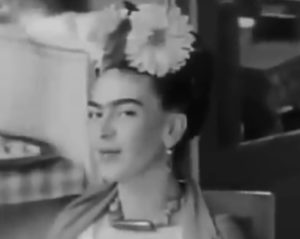 years later, while Frida and Diego lived in their new residence in the wealthy upscale San Angel neighborhood. Even though it was well known that Kahlo had an affair with Trotsky during his Mexican exile, later in life Frida would claim that her alliance with him and the Trostskyite communists was an error and her real admiration was for strongman Josef Stalin, who ruled the Soviet Union with impunity and was responsible for a terrible oppression in that country that led to the deaths of tens of millions of people. One of Frida’s last paintings was titled “Self Portrait with Stalin.” It was during the 1930s and the rise of fascism in Europe that Frida started claiming that she was Jewish, seemingly to ride the wave of sympathy of oppression of Jews in Europe and to turn her back on her German heritage on her father’s side. A 2006 investigation done by the Jerusalem Post set out to prove or disprove Frida Kahlo’s Jewishness. The newspaper traced Kahlo’s European lineage back to the 16th Century and while they found a long line of craftsmen, soldiers and gingerbread makers, they found no evidence at all that Frida was even remotely Jewish. In the Jerusalem Post article it was even mentioned that in 1949 Frida had written to her father asking about a possible Jewish background and he told her that there wasn’t any and that they were from a long line of Lutherans. That did not stop Frida from using more “artistic license” in her life and she held on to the claim of Jewish heritage until she died. Frida’s Jewishness went hand in hand with her emphasizing her indigenous heritage. While real, her Native roots was very remote from her. Frida’s mother was a mestiza, or of mixed Native and European descent, but she had no connection to any sort of tribal culture and was generations and generations removed from anything authentically indigenous. It all fed into Frida’s self-made brand of what leftists would today call, “intersectionality,” and she used it for own ends and to fulfill
years later, while Frida and Diego lived in their new residence in the wealthy upscale San Angel neighborhood. Even though it was well known that Kahlo had an affair with Trotsky during his Mexican exile, later in life Frida would claim that her alliance with him and the Trostskyite communists was an error and her real admiration was for strongman Josef Stalin, who ruled the Soviet Union with impunity and was responsible for a terrible oppression in that country that led to the deaths of tens of millions of people. One of Frida’s last paintings was titled “Self Portrait with Stalin.” It was during the 1930s and the rise of fascism in Europe that Frida started claiming that she was Jewish, seemingly to ride the wave of sympathy of oppression of Jews in Europe and to turn her back on her German heritage on her father’s side. A 2006 investigation done by the Jerusalem Post set out to prove or disprove Frida Kahlo’s Jewishness. The newspaper traced Kahlo’s European lineage back to the 16th Century and while they found a long line of craftsmen, soldiers and gingerbread makers, they found no evidence at all that Frida was even remotely Jewish. In the Jerusalem Post article it was even mentioned that in 1949 Frida had written to her father asking about a possible Jewish background and he told her that there wasn’t any and that they were from a long line of Lutherans. That did not stop Frida from using more “artistic license” in her life and she held on to the claim of Jewish heritage until she died. Frida’s Jewishness went hand in hand with her emphasizing her indigenous heritage. While real, her Native roots was very remote from her. Frida’s mother was a mestiza, or of mixed Native and European descent, but she had no connection to any sort of tribal culture and was generations and generations removed from anything authentically indigenous. It all fed into Frida’s self-made brand of what leftists would today call, “intersectionality,” and she used it for own ends and to fulfill 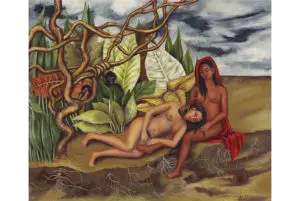 a series of her own agendas.
a series of her own agendas.
An offshoot of Frida’s politics often explored especially lately is the topic of Frida Kahlo’s “Feminism.” Indeed, in the decades since her death, Kahlo has been transformed into a sort of feminist icon. Scant information exists, however, as to what Frida actually did to advance the causes of women. In the top article online with a Google search titled “6 Reasons Why Frida Kahlo is a Feminist Icon,” author/blogger Maddy Crehan gives one of the reasons as “She’s just so damn fierce,” along with “She embraced weirdness.” While we might think that Frida was somewhat unconventional for her time, we must realize that the early permissive years spent in the bohemian scene of Roaring Twenties Mexico City had a definite influence on her. She was doing pretty much what everyone else was doing at the time and that included her share of gender bending and following the trendies. Her flamboyant indigenous-inspired mode of dress may not have even been her own creation. While married to Diego, Rivera had his opinions of women’s dress which stemmed from his communist ideology. He was quoted as saying that Mexican women who do not wear Mexican clothing, “are mentally and emotionally dependent on a foreign class to which they wish to belong.” Perhaps Frida’s way of clothing herself was a kind of uniform of sorts to signal that she was rejecting the Old Order so shunned by the intellectual communist elite in Mexico at the time. Kahlo’s very relationship with Rivera seems to destroy the notion that she was any sort of feminist, politically or otherwise. A major part of her art and her life was defined by her relationship to a man, notably her husband. She wrote thousands of words of her heartache, her torment, and her joy as defined by her husband. The following is a quotation from her voluminous writings on the topic of her husband: “Nothing compares to your hands, nothing like the green-gold of your eyes. My body is filled with you for days and days. You are the mirror of the night. The violent flash of lightning. The dampness of the earth. The hollow of your armpits is my shelter. My fingers touch your blood. All my joy is to feel life spring from your flower-fountain that mine keeps to fill all the paths of my nerves which are yours.” Quotes like these are numerous and dispel the myth that Frida was a strong feminist as she defined herself primarily by a relationship to a man, Diego Rivera, who often treated her unkindly, cheated on her, lied to her, and it made no difference as she always went back to him.
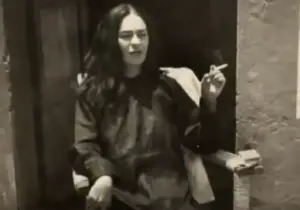 Frida professed communism with greater intensity the older she got and the more life became difficult for her. Because of childhood illnesses and a tragic bus accident as a young woman, Frida suffered through dozens of surgeries and medical treatments and in the last years of her life she ended up a bedridden morphine addict. There was a part of her that believed that communism equaled community and that this political ideology would protect her from being alone, which was one of her greatest fears. She ramped up her political writings from her bed and her paintings took on a more ideological bent. Although she had been a card-carrying communist for over a quarter century, she had ignored Rivera’s example of using his art and talents to further political causes and spent most of her time as a painter painting portraits of herself. The later years, with her world closing in on her, Frida finally decided to take on more political themes and began to sound more “activistic” in her writings. By July 13, 1954, it was too late, however, and the physical and mental anguish had overtaken her.
Frida professed communism with greater intensity the older she got and the more life became difficult for her. Because of childhood illnesses and a tragic bus accident as a young woman, Frida suffered through dozens of surgeries and medical treatments and in the last years of her life she ended up a bedridden morphine addict. There was a part of her that believed that communism equaled community and that this political ideology would protect her from being alone, which was one of her greatest fears. She ramped up her political writings from her bed and her paintings took on a more ideological bent. Although she had been a card-carrying communist for over a quarter century, she had ignored Rivera’s example of using his art and talents to further political causes and spent most of her time as a painter painting portraits of herself. The later years, with her world closing in on her, Frida finally decided to take on more political themes and began to sound more “activistic” in her writings. By July 13, 1954, it was too late, however, and the physical and mental anguish had overtaken her.
Because Frida was somewhat ambiguous during her life and shifted a lot according to trends and fashions, many people decades after her death ascribe things to Frida Kahlo that had very little to do with her. She is often described as being very political, but just a brief exploration of this topic shows she had little in the form of solid ideology and very seldom lived by her alleged convictions. This fact hasn’t stopped people from venerating her in almost a religious fashion to this day. She is an icon for feminists, “People of Color,” persons with disabilities, Mexican-Americans and the LGBT “community.” She is everything to everyone. Since her death, Frida has become like water and takes the shape of whatever vessel a person brings to her to fill. The fact that the reality of Frida Kahlo is not what most people think does not seem to matter to her cultish followers.
REFERENCES USED (This is not a formal bibliography)
Frida: A Biography of Frida Kahlo by Hayden Herrera We are an Amazon affiliate. Get a copy of this book here: https://amzn.to/2STkSer
The Diary of Frida Kahlo: An Intimate Self-Portrait by Carlos Fuentes
“Frida Kahlo’s Father Wasn’t Jewish After All” by Meier Ronnin in The Jerusalem Post

13 thoughts on “Frida Kahlo’s Politics”
Excellent!
Gracias!
perfeto
What an ugly and bitter article.
I didn’t say/write anything that wasn’t true. If I made some error of fact, please do me the courtesy of correcting me. Otherwise, we are left with the fact that Frida falls WAAAAY short of the status afforded to her by American “Latinos” who are looking so desperately for an icon. Try harder.
I believe you are incorrect, and that is only your perception of her, but it is what it is for you and you alone.
You can “believe” what you want about what I said, but my presentation has nothing to do with my perception of her, but it is based on facts. It’s obviously not for me and for me alone because everything I talked about came from outside sources, not my own personal perception of the truth. Yeah, I exposed Frida for the fraud she was and that’s too bad for the “true believers” and those who want to idolize her and make her into something she wasn’t. You can continue to believe whatever you want about her, but I clearly showed that she followed the trends while having no clear ideology of her own, wore an Indian “drag queen” costume to claim a heritage that was not hers and did NOTHING to help women (so she can’t be called a feminist). It’s sad that so many “Latinos” have turned her into an icon, but maybe that indicates that there is no one else to draw from. That’s even more tragic.
Wow, this is a great read! Glad to read an article with linked facts to your work. It’s shedding light to the regurgitation of the “New Age” bullshit. I will be sharing your article knowing that I will get “hate” and “misinformation for it. Thank you.
Thank you Laura!
no
yes!
Visited the exhibition of Frida Kahlo’s work in Budapest today. See http://mng.hu/temporary_exhibitions/frida-kahlo-122938.
It was overwhelming, however the works mainly stressed her life’s suffering as the basis to her art. Too much to my opinion. Your article gives me more insight as to how Frida was as a political, social person.
Well done!
Thank you.